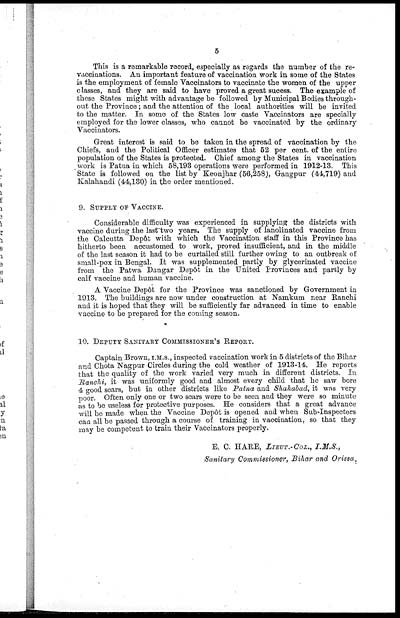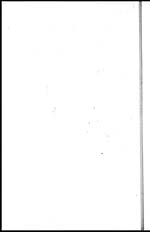Medicine - Vaccination > 1911-1928 - Annual vaccination report of Bihar and Orissa > 1911-1914 - Triennial report on vaccination, Bihar and Orissa, for the years 1911-12, 1912-13 & 1913-14
(15) Page 5
Download files
Individual page:
Thumbnail gallery: Grid view | List view

5
This is a remarkable record, especially as regards the number of the re-
vaccinations. An important feature of vaccination work in some of the States
is the employment of female Vaccinators to vaccinate the women of the upper
classes, and they are said to have proved a great sucess. The example of
these States might with advantage be followed by Municipal Bodies through-
out the Province; and the attention of the local authorities will be invited
to the matter. In some of the States low caste Vaccinators are specially
employed for the lower classes, who cannot be vaccinated by the ordinary
Vaccinators.
Great interest is said to be taken in the spread of vaccination by the
Chiefs, and the Political Officer estimates that 52 per cent. of the entire
population of the States is protected. Chief among the States in vaccination
work is Patna in which 58,193 operations were performed in 1912-13. This
State is followed on the list by Keonjhar (56,258), Gangpur (44,719) and
Kalahandi (44,130) in the order mentioned.
9. SUPPLY OF VACCINE.
Considerable difficulty was experienced in supplying the districts with
vaccine during the last two years. The supply of lanolinated vaccine from
the Calcutta Depôt with which the Vaccination staff in this Province has
hitherto been accustomed to work, proved insufficient, and in the middle
of the last season it had to be curtailed still further owing to an outbreak of
small-pox in Bengal. It was supplemented partly by glycerinated vaccine
from the Patwa Dangar Depôt in the United Provinces and partly by
calf vaccine and human vaccine.
A Vaccine Depôt for the Province was sanctioned by Government in
1913. The buildings are now under construction at Namkum near Ranchi
and it is hoped that they will be sufficiently far advanced in time to enable
vaccine to be prepared for the coming season.
10. DEPUTY SANITARY COMMISSIONER'S REPORT.
Captain Brown, I.M.S., inspected vaccination work in 5 districts of the Bihar
and Chota Nagpur Circles during the cold weather of 1913-14. He reports
that the quality of the work varied very much in different districts. In
Ranchi, it was uniformly good and almost every child that he saw bore
4 good scars, but in other districts like Patna and Shahabad, it was very
poor. Often only one or two scars were to be seen and they were so minute
as to be useless for protective purposes. He considers that a great advance
will be made when the Vaccine Depôt is opened and when Sub-Inspectors
can all be passed through a course of training in vaccination, so that they
may be competent to train their Vaccinators properly.
E. C. HARE, LIEUT.-COL., I.M.S.,
Sanitary Commissioner, Bihar and Orissa.
Set display mode to: Large image | Zoom image | Transcription
Images and transcriptions on this page, including medium image downloads, may be used under the Creative Commons Attribution 4.0 International Licence unless otherwise stated. ![]()
| Permanent URL | https://digital.nls.uk/91543899 |
|---|




